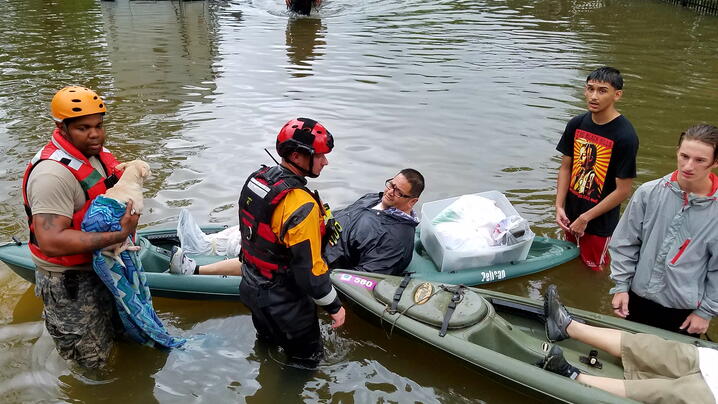
As Hurricane Harvey relief efforts begin in Houston and its surrounding cities, communities will inevitably see an increase in the number of volunteers who want to help with the process. Although volunteers can be a critical asset for emergency management, numerous legal issues may arise from taking advantage of volunteer resources. To ensure the safety of your organization and residents, consider the following excerpts from our Emergency Management: Principles and Practice for Local Government e-book.
The first question to address is the matter of definition: who is a volunteer?
Simply showing up at the scene of an event does not render one a volunteer. On the contrary, one of the greatest challenges is the throng of well-meaning individuals who assemble at a disaster scene: experience shows that “emergent responders” will arrive at the scene individually or as a group, even if assistance has not been requested, and even after active attempts have been made to prevent would-be volunteers from converging on the scene. These individuals are often not affiliated with any organizations that are formally integrated into the EOP, their skills and training are unknown, and they make the job of the incident commander—who is responsible for securing the scene—all the more difficult.
The incident commander must use both determination and diplomacy to preserve control of the site.
One of the incident commander’s first responsibilities is the organization of a perimeter, which should be controlled by law enforcement. Anyone who tries to enter the perimeter without proper authorization must be prevented from doing so and removed to a distant staging area. There, training and capabilities can be assessed, and the individual’s proper role, if any, can be assigned.
To protect against liability, volunteers must be properly integrated into the emergency management team.
In the event that emergent volunteers are found to be trained responders with needed skills, a record of the assessment must be made. Only then can they be officially registered as volunteers. Once they have been registered, the volunteers are available for the incident commander, or his or her delegated representatives, to employ. Formally assessing and registering volunteers will help to shield the emergency management agency and other responding entities from liability, as it demonstrates that reasonable care has been taken to determine the competencies of the volunteers. Of course, the incident commander has an accompanying duty to assign the volunteers to duties for which they are qualified. (William C. Nicholson, “Legal Issues in Emergency Response to Terrorism Incidents Involving Hazardous Materials: The Hazardous Waste Operations and Emergency Response (‘HAZWOPER’) Standard, Standard Operating Procedures, Mutual Aid and the Incident Management System.")
Establish long-term relationships with the most important volunteer groups well before a crisis.
The role of volunteer organizations should be described in the plan, and these organizations, like all other emergency response entities, should participate in planning, training, and exercising. Typically, the sponsoring organization ensures that volunteers are properly trained and provides them with credentials that identify them as people who may be on the scene during an event. Credentials make the safety officer’s job less onerous and remove a significant administrative burden from the incident commander.
Remember: Most volunteers converge within the first weeks after the disaster.
However, most of the help is needed during rebuilding, so care must be taken to ensure that volunteers are managed to their most effective levels. One strategy for doing this may be to develop a plan to bring those volunteers back during the recovery period. Working with voluntary organizations is one way to ensure that work crews will return at the appropriate time with needed skills. Local government may facilitate that effort by identifying locations for volunteer tent cities or other types of accommodation, such as a church camp, a local dormitory, or even a formerly closed nursing home.
For more on volunteers or local emergency management, download the e-book today!
Related Resources:
- Strategic Disaster Planning
- Podcast: Community and Organizational Volunteerism
- 4 Steps to Disaster Preparedness through Volunteer Engagement
- How to Build a Successful Volunteer Program [Checklist]
*National Guard photo by Staff Sgt. Tim Pruitt
New, Reduced Membership Dues
A new, reduced dues rate is available for CAOs/ACAOs, along with additional discounts for those in smaller communities, has been implemented. Learn more and be sure to join or renew today!
